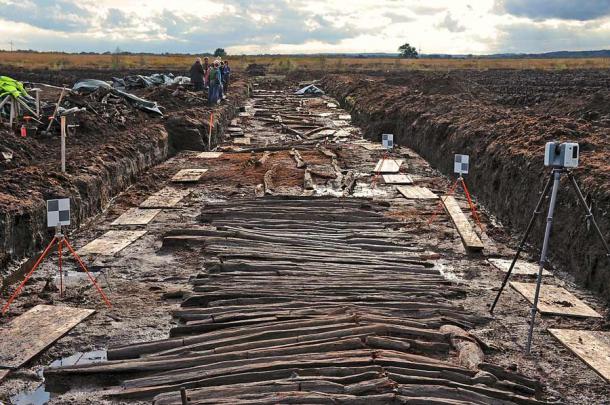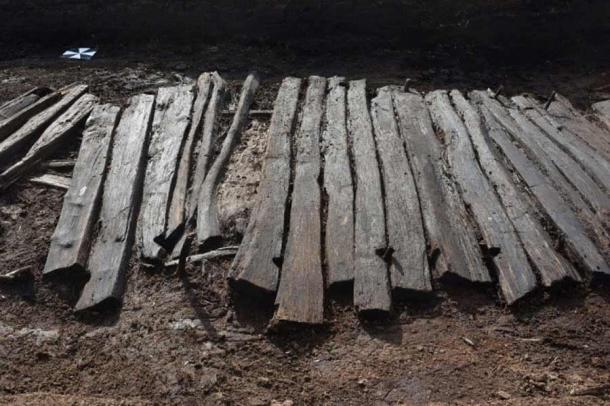2,000-Year-Old Shoe Unearthed in German Bog

Bogs have been home to some of the weirdest items and artifacts, some that were buried or stored intentionally, and others that were inadvertently lost in the mud. The archaeological record is full of bizarre finds including barrels full of butter to well-preserved human bodies, murder weapons, wheels, or tools. Archaeologists have now made another discovery in the “bogosphere”, within the mystery-laden moors of Lower Saxony in northern Germany. The very well-preserved leather artifact, a 2,000-year-old shoe, was found alongside the remains of a wooden road dating back to the Bronze Age.

Breakthrough in the Bog: The Story of the 2,000-Year-Old Shoe
It is a kind of a sandal that is gathered at the front end and held together by a strap, and by far the oldest shoe ever found in the area. Leather shoes have been discovered of course, but they are not more than a few decades or a couple of centuries old at best. This shoe, which dates back to a time before industrial production, is finely hand-crafted, made specifically for its wearer, and has stood the test of time.
It is entirely possible that, since the other half of the pair could not be found, the 2,000-year-old shoe got stuck in the mud for good while its owner was pushing a cart on an unusually sticky and wet day. Perhaps it slipped off inadvertently and was very difficult to recover, as the remains of a broken carriage axle were also pulled from the bog.
The so-called “road” was a collection of wooden boards placed together to provide a passageway over a tricky piece of earth. The acidic conditions of the bog are ideal for the preservation of such material, which is why bogs are such a prolific source of well preserved remains, including human bog bodies.

Unearthing a Bronze Age Bog Trail
In a statement published by the Lower Saxony State Office for Monument Preservation, the excavation and surveying company Denkmal 3D from Vechta in Germany explained that “the axle of a wooden cart, probably pulled by cattle, broke in two and the cart had an accident on the bumpy road. While doing this or trying to recover the parts, the owner of the shoe fell or stepped beside the path and the shoe got stuck in the sticky mud.”
This part of Lower Saxony has a rich history of finding artifacts of this kind, providing a window into the history of settlement and transportation, due to the existence of a multitude of bogs. “In order to cross the once extensive moorland, people here built paths and roads out of wood for over 6,000 years until modern times. More than 500 such paths are known from Lower Saxony,” highlights the press release.

Bohlenweg Pr 6: One of the Longest Bog Trails in the World
According to The Daily Mail, the road itself was built during the late Bronze Age (1200 to 600 BC). The ancient wooden path, known as Bohlenweg Pr 6, was one of the longest bog trails in the world, originally 4.2 kilometers (2.6 miles) long to be precise. It was discovered in 1817 and, thanks to several archaeological projects over the last two centuries, it is now one of the most well researched in the region.
This prehistoric moor path crossed the bog between Diepholz and Lohne over 2,000 years ago. It has been under excavation since 2019 and the archaeological digs have concluded that it was created in the year 46 BC, a little over 2,000 years ago. In order to build this bog path, enormous amounts of wood and an army of construction workers were required.
Bogs and their Rich Preservation of History
“The moors of Lower Saxony hold the testimony of many thousands of years of history,” explained Lower Saxony’s Minister for Science and Culture, Björn Thümler. “They are a unique archive, as they have not only preserved processed shards and metal objects as decisive evidence of our history, but also organic finds.” This is the reason for why the Lower Saxony Office for Monument Preservation decided to excavate about 500 meters (1,640 ft) of this ancient bog path between 2019 and 2022.
Star-Crossed Lovers? Criminals? Or Strangers? The Mystery of the Windeby Bog Bodies
Corlea Trackway Holds the Echoes of 2000-year-old Footsteps
The ability of bogs to preserve organic artifacts creates an environment tantamount to a goldmine for archaeologists. Since excavations began, they have discovered a plethora of artifacts including wooden idols. “A shoe that is lost and found again after 2,000 years, the oldest shoe from Lower Saxony to date, is an immensely personal testimony to a previous life,” stressed Thümler.
“It is one of those testimonies that make time tangible as if under a magnifying glass,” continued Thümler. Indeed, the existence of this particular 2,000-year-old shoe acknowledges that despite the passage of time, a simple leather shoe has lived to provide a glimpse of the lives lived in another era. It is nevertheless not the oldest shoe discovered to date. Back in 2010, ScienceDaily published the story of a “perfectly preserved shoe” which had survived in Armenia for 5,500 years.



